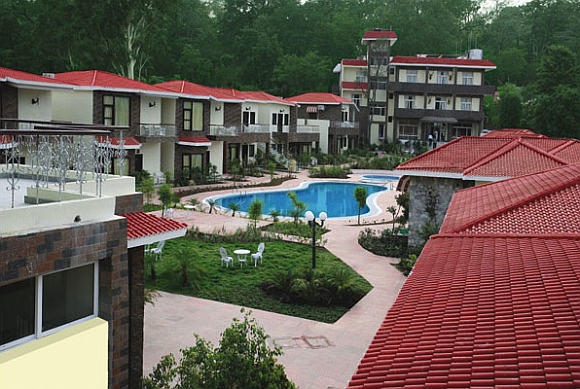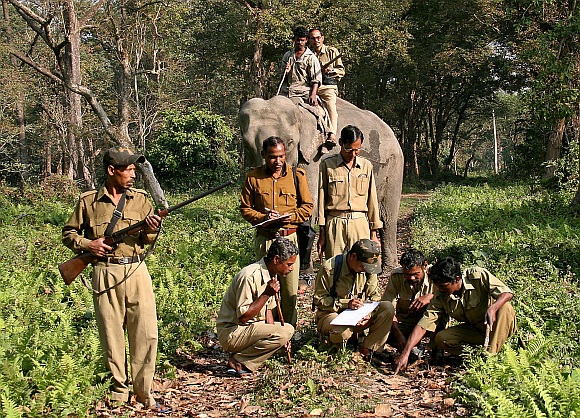 | « Back to article | Print this article |
Corbett has GOT TO put its focus back on tigers
In this third and final part of the three-par series, Kumar Sambhav Shrivastava finds out that wildlife management has taken a backseat, as Corbett pulls in droves of tourists
About 150 resorts dotting Corbett’s periphery can accommodate close to a whopping 5,000 tourists, say forest officials. But these visitors will require either luck or wads of cash to go on safari. That’s because in a day only 150 vehicles are allowed inside the park which can carry no more than 900 tourists. Those who can pay resort owners a fee several times higher than the prescribed charges go on safari, for the rest the resort owners often try other means of keeping them entertained.
Part 1: Tiger deaths at Corbett: Dark twist to a bright tale
The mad rush has led to pervasive corruption in booking safaris and forest guesthouses inside the reserve. A forest official who did not want to be named alleged a handful of hoteliers were running the show in Corbett.
“They have their people in the forest staff who get them secured bookings, which are then sold to tourists at exorbitant rates. Small hoteliers also have to depend on the big fish for bookings,” he said. When this correspondent tried to book a visit on his own he could not get a permit even after four days.
Part 2: Besides tiger deaths, Corbett plagued by land sharks, politics
The manager of the resort where this correspondent stayed, though, offered him safari and night-stay at a forest guesthouse inside the reserve at double the prescribed rates and without the mandatory presence at the booking counter.
Click NEXT to read further...
Despite guidelines, forest guesthouses are still hosting tourists
Since tiger is the crowd-puller, resort owners at times try unethical ways of entertaining the tourists who do not get the chance to go inside the forest. A few years ago, a resort in Garjia allegedly threw dead bait along the river in its backyard to attract the tiger. The spot was then crowded by elephant safaris. Till recently, many resorts offered DJ nights, rain dance and discs to the tourists. It was only in April last year that the government declared the area up to 500 m from the reserve’s boundary a silent zone.
State-run tourism complexes inside the core area are no better. National Tiger Conservation Authority’s guidelines on tourism in tiger reserves issued last year say permanent tourism structures in core areas should be phased out. But forest guesthouses are still hosting tourists.
Haphazard tourism growth has played a major part in inducing the human-animal conflict. A 2010 report by the Union ministry of tourism on wildlife in Corbett notes, “Baiting and the consequent increasing interface with humans familiarises the tigers with people and they lose their instinctive fear of humans. This could lead to unnatural behaviour like killing people.”
In 2010, a tiger mauled six people in Sunderkhal village near Garjia. Another tiger killed a woman of the same village the previous year.
Click NEXT to read further...
Corbett is getting crowded from all sides
Tourism is also contributing to tiger attacks by blocking wildlife corridors. Numerous hotels on the Ramnagar-Ranikhet road along the KosiRiver have left only two narrow passages for wildlife to access the Kosi -- one at Garjia and the other at Ringoda. Even these corridors are crowded by elephant safaris and gypsies from resorts for tiger sighting.
Several wildlife lovers who also own resorts along the Kosi have been pressuring the government for relocation of Sunderkhal -- which as per the forest department is an encroachment -- saying this will open up the Kosi corridor to a large extent.
Corbett is getting crowded from all sides. Sindhikhal, Rathuadhab, Kandanala, Tera, Marchula and Mohan villages on the north -- eastern and northern border are the upcoming tourism hot spots. In Kotabagh area where resorts have mushroomed, human-elephant conflict has become a regular phenomenon.
Click NEXT to read further
'The park cannot accommodate so many tourists'
As Ramesh Suyal, who has been a guide at Corbett for 10 years, says, “It was a rage. Everybody was busy building multi-story resorts but nobody thought that the park cannot accommodate so many tourists.”
For obvious reasons, the attention of the forest staff and many officials seems to be more on “managing” tourism rather than protecting tigers. “I have seen the guards, rangers and other forest staff posted on tourism management duties going from rags to riches,” says a small-time safari operator in Dhikuli. “On the other hand, for the guards and rangers engaged in patrolling there is hardly any reward.”
The tiger deaths are a reminder of this skewed focus. Amid all the allegations, tourism boom and politics, it is difficult to solve the mystery of tiger deaths. But Corbett has no option but to put the focus back on tigers.
TOP photo features of the week
Click on MORE to see another set of PHOTO features...




